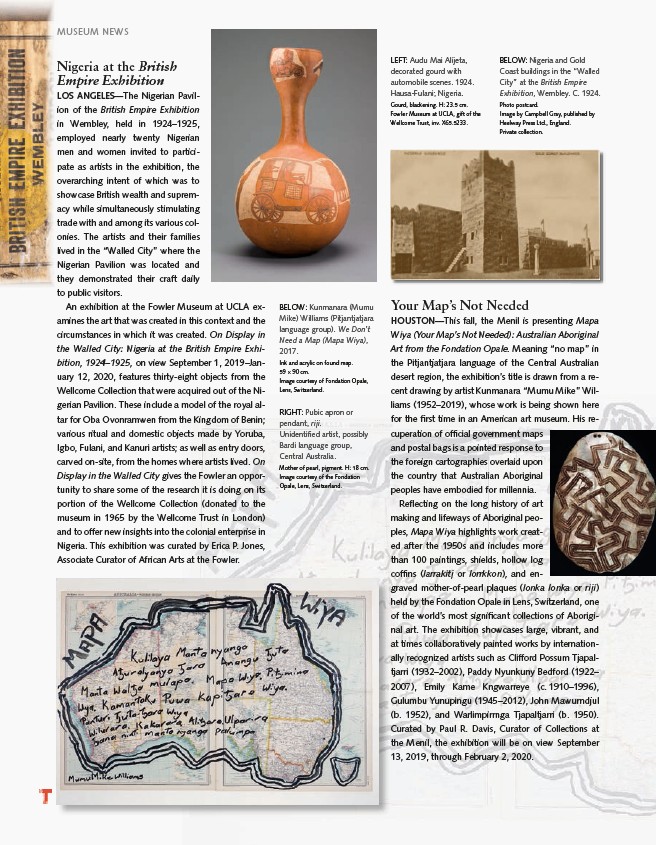
Nigeria at the British
Empire Exhibition
LOS ANGELES—The Nigerian Pavilion
28
of the British Empire Exhibition
in Wembley, held in 1924–1925,
employed nearly twenty Nigerian
men and women invited to participate
as artists in the exhibition, the
overarching intent of which was to
showcase British wealth and supremacy
while simultaneously stimulating
trade with and among its various colonies.
The artists and their families
lived in the “Walled City” where the
Nigerian Pavilion was located and
they demonstrated their craft daily
to public visitors.
An exhibition at the Fowler Museum at UCLA examines
the art that was created in this context and the
circumstances in which it was created. On Display in
the Walled City: Nigeria at the British Empire Exhibition,
1924–1925, on view September 1, 2019–January
12, 2020, features thirty-eight objects from the
Wellcome Collection that were acquired out of the Nigerian
Pavilion. These include a model of the royal altar
for Oba Ovonramwen from the Kingdom of Benin;
various ritual and domestic objects made by Yoruba,
Igbo, Fulani, and Kanuri artists; as well as entry doors,
carved on-site, from the homes where artists lived. On
Display in the Walled City gives the Fowler an opportunity
to share some of the research it is doing on its
portion of the Wellcome Collection (donated to the
museum in 1965 by the Wellcome Trust in London)
and to offer new insights into the colonial enterprise in
Nigeria. This exhibition was curated by Erica P. Jones,
Associate Curator of African Arts at the Fowler.
LEFT: Audu Mai Alijeta,
decorated gourd with
automobile scenes. 1924.
Hausa-Fulani; Nigeria.
Gourd, blackening. H: 23.5 cm.
Fowler Museum at UCLA, gift of the
Wellcome Trust, inv. X65.5233.
BELOW: Nigeria and Gold
Coast buildings in the “Walled
City” at the British Empire
Exhibition, Wembley. C. 1924.
Photo postcard.
Image by Campbell Gray, published by
Heelway Press Ltd., England.
Private collection.
BELOW: Kunmanara (Mumu
Mike) Williams (Pitjantjatjara
language group). We Don’t
Need a Map (Mapa Wiya),
2017.
Ink and acrylic on found map.
59 × 90 cm.
Image courtesy of Fondation Opale,
Lens, Switzerland.
RIGHT: Pubic apron or
pendant, riji.
Unidentifi ed artist, possibly
Bardi language group,
Central Australia.
Mother of pearl, pigment. H: 18 cm.
Image courtesy of the Fondation
Opale, Lens, Switzerland.
Your Map’s Not Needed
HOUSTON—This fall, the Menil is presenting Mapa
Wiya (Your Map’s Not Needed): Australian Aboriginal
Art from the Fondation Opale. Meaning “no map” in
the Pitjantjatjara language of the Central Australian
desert region, the exhibition’s title is drawn from a recent
drawing by artist Kunmanara “Mumu Mike” Williams
(1952–2019), whose work is being shown here
for the fi rst time in an American art museum. His recuperation
of offi cial government maps
and postal bags is a pointed response to
the foreign cartographies overlaid upon
the country that Australian Aboriginal
peoples have embodied for millennia.
Refl ecting on the long history of art
making and lifeways of Aboriginal peoples,
Mapa Wiya highlights work created
after the 1950s and includes more
than 100 paintings, shields, hollow log
coffi ns (larrakitj or lorrkkon), and engraved
mother-of-pearl plaques (lonka lonka or riji)
held by the Fondation Opale in Lens, Switzerland, one
of the world’s most signifi cant collections of Aboriginal
art. The exhibition showcases large, vibrant, and
at times collaboratively painted works by internationally
recognized artists such as Clifford Possum Tjapaltjarri
(1932–2002), Paddy Nyunkuny Bedford (1922–
2007), Emily Kame Kngwarreye (c. 1910–1996),
Gulumbu Yunupingu (1945–2012), John Mawurndjul
(b. 1952), and Warlimpirrnga Tjapaltjarri (b. 1950).
Curated by Paul R. Davis, Curator of Collections at
the Menil, the exhibition will be on view September
13, 2019, through February 2, 2020.
MUSEUM NEWS